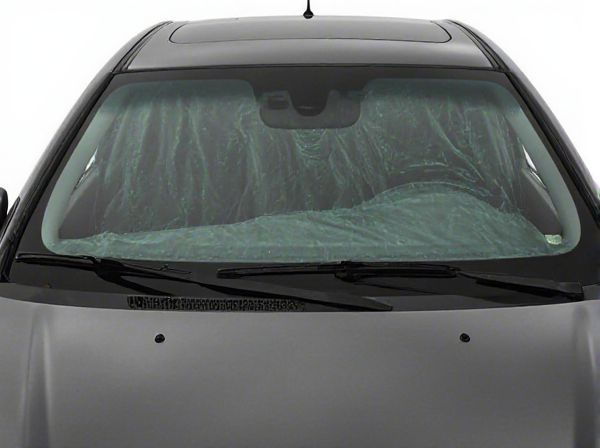
Photo illustration: Heated vs Non-Heated Windshield
Heated windshields use embedded heating elements to quickly melt ice and snow, improving visibility and safety during cold weather. Non-heated windshields rely solely on ambient temperature and windshield wipers, requiring manual scraping or defrosting, which can be time-consuming. Choosing a heated windshield reduces your defrosting effort and enhances driving comfort in winter conditions.
Table of Comparison
| Feature | Heated Windshield | Non-Heated Windshield |
|---|---|---|
| Defrosting Speed | Fast, clears ice and fog quickly | Slow, requires manual scraping or external heat |
| Visibility | Improves visibility during cold weather | May impair vision due to frost or fog build-up |
| Cost | Higher initial purchase and replacement cost | Lower cost, widely available standard option |
| Energy Consumption | Uses vehicle electrical system power | No energy consumption |
| Durability | Durable, designed to withstand heating elements | Standard durability without additional features |
| Installation | Specialized installation required | Standard installation process |
Introduction to Windshield Technologies
Heated windshields incorporate embedded heating elements that rapidly defrost and defog the glass, enhancing visibility and safety in cold weather conditions. Non-heated windshields rely solely on external factors such as climate control systems and manual scraping to remove ice or condensation, which may take longer and require more effort. Advanced windshield technologies continue to evolve, integrating materials like infrared-reflective coatings to improve thermal efficiency and driving comfort.
What Is a Heated Windshield?
A heated windshield contains integrated heating elements that quickly melt ice and snow, improving visibility and safety during cold weather. These windshields use thin conductive wires or a transparent coating embedded within the glass to generate heat evenly across the surface. Unlike non-heated windshields, heated versions eliminate the need for manual scraping and reduce defrosting time significantly.
How Non-Heated Windshields Work
Non-heated windshields rely on ambient temperature and airflow to prevent fogging and ice buildup, utilizing special coatings or layered glass to improve thermal insulation. These windshields are designed to minimize heat loss from the cabin and reduce condensation without active heating elements. By maintaining a stable surface temperature, they help ensure clear visibility in moderate weather conditions.
Key Differences Between Heated and Non-Heated Windshields
Heated windshields incorporate embedded heating elements that rapidly melt ice and snow, providing improved visibility and safety during cold weather conditions. Non-heated windshields lack these built-in heating features, relying solely on external heating sources like defrosters or manual scraping. The key differences include faster defrosting times, reduced fogging, and enhanced driver convenience in heated windshields compared to the limited frost resistance of non-heated models.
Advantages of Heated Windshields
Heated windshields offer faster defrosting and de-icing capabilities compared to non-heated windshields, enhancing visibility and safety during cold weather conditions. They reduce the need for manual scraping and prevent fog buildup by evenly distributing heat across the glass surface. This technology increases driving comfort and convenience, particularly in regions with frequent frost or snow.
Benefits of Non-Heated Windshields
Non-heated windshields offer the benefit of reduced initial cost and lower energy consumption compared to heated models, making them an economical choice for drivers in mild climates. These windshields typically have fewer electrical components, which translates to increased durability and reduced maintenance requirements over time. Non-heated windshields also pose less risk of electrical failure, ensuring consistent visibility without reliance on heating elements.
Cost Comparison: Heated vs Non-Heated Windshields
Heated windshields typically cost between $300 and $1,000 more than non-heated versions due to integrated heating elements and advanced materials. Installation and repair expenses for heated windshields are higher because of the complexity involved in working with embedded wires or coatings. Non-heated windshields offer a more budget-friendly option with straightforward replacement costs usually ranging from $200 to $400.
Maintenance and Durability Considerations
Heated windshields require careful maintenance to ensure the embedded heating elements remain functional, avoiding damage from sharp tools or abrasive cleaners that can disrupt electrical circuits. Non-heated windshields generally offer greater durability due to their simpler construction, requiring standard cleaning and occasional chip repairs without concern for electrical components. Choosing between the two depends on balancing the ease of maintenance with the enhanced de-icing performance of heated glass, impacting long-term durability and repair costs.
Safety Implications and Driving Comfort
Heated windshields significantly improve safety by rapidly clearing ice, frost, and fog, ensuring better visibility in cold weather and reducing the risk of accidents caused by impaired vision. Non-heated windshields rely on manual defrosting or vehicle heating systems, which take longer to clear, potentially compromising driver response time during critical moments. Enhanced driving comfort with heated windshields comes from consistent clarity and warmth, minimizing distractions and allowing drivers to focus on the road.
Choosing the Right Windshield for Your Vehicle
Heated windshields incorporate embedded heating elements that rapidly melt ice and fog, enhancing visibility during cold conditions, making them ideal for vehicles in colder climates or regions with frequent winter weather. Non-heated windshields rely solely on defrosters and windshield wipers, which may suffice in milder environments but can result in longer wait times to achieve clear visibility. Selecting the right windshield depends on your typical climate, driving conditions, and preference for maintenance convenience and safety features.
 caratoz.com
caratoz.com